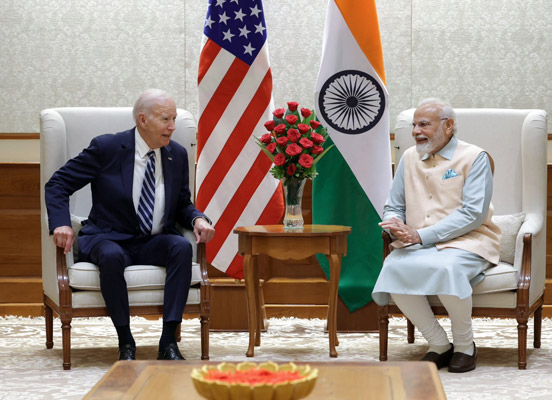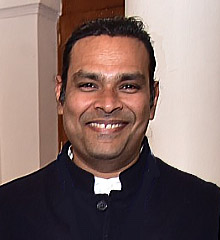
By Vipul Tamhane
In the realm of democratic governance, India and the United States stand as global benchmarks, each with their unique electoral systems reflecting their diverse political landscapes. Home to the world's two largest democracies, the two nations boast rich histories of electoral practices. While the USA has entrenched democratic roots spanning nearly 240 years, India's vibrant parliamentary democracy emerged in the aftermath of colonial rule, evolving over the past seven decades.
India's general elections are the largest democratic exercise in the world, with over 900 million eligible voters having participated in the 2019 elections. Despite their shared commitment to democratic principles and the electoral systems, a closer examination reveals intriguing disparities in their electoral mechanisms i.e. organization and execution, representation structures, and party dynamics.
At the heart of their democratic processes, a fundamental distinction between the electoral landscapes of India and the USA lies in the type of democracy practiced and their party systems for public representation. India operates under a parliamentary democracy, where her political tableau is marked by the proliferation of regional parties alongside national contenders such as the Indian National Congress and the Bharatiya Janata Party (BJP). This multiplicity of parties reflects the diverse socio-political fabric of India, where regional interests often hold sway over national mandates.
Conversely, in the USA, the political arena is predominantly defined by the dichotomy between the Democratic and Republican parties, each espousing distinct ideologies wherein the citizens embrace a presidential democracy. Further differentiating these systems is the Presidential vs Parliamentary Systems method of voting employed. India embraces a parliamentary system, where the citizens cast their ballots via a direct voting system, exercising their franchise to elect individual candidates in their respective constituencies for members of the Lok Sabha. This model fosters intimate ties between the executive and legislative branches, with the Prime Minister usually emerging from the majority party or majority in alliance with Parliament, who subsequently elect the Prime Minister who holds the reins of government.
In stark contrast, the USA operates under a presidential system, featuring distinct executive, legislative, and judicial branches. The US citizens vote for electors who, in turn, cast ballots for the President through the Electoral College system. The President, elected independently, serves as both head of state and government. India and the USA have distinct electoral systems, with India having a multi-tiered system at national, state, and local levels, promoting decentralized governance and grassroots participation. The USA operates on a two-tiered system with federal and state levels dominating the electoral landscape. India emphasizes proportional representation, with reserved seats for marginalized groups.
The USA has a mix of proportional representation in Congress and equal representation in the Senate, creating a unique balance of power between states and the federal government. Both countries' party systems reflect their distinct political cultures, with India's multi-party system characterized by regional and national parties, and the USA's two-party dominance.
India and the USA have distinct electoral systems, with India using the Electoral Voting Machine (EVM) for voting. NRIs and Indian diplomats stationed overseas are included in the electoral rolls from these past general elections in 2024. The USA has a more complex voting system, including in-person polling, absentee ballots, and early voting. The autonomy and authority of election bodies also differ. In India, the Election Commission has a broader range of powers, including organizing elections, enforcing financial regulations, and ensuring the sanctity of the electoral process.
The electorate in India is around four times greater than that in the US, 20 times larger than that in the UK, and seven times larger than that in Pakistan. Voter turnout serves as a barometer of civic engagement and political participation in democratic societies. India's consistently high voter turnout, surpassing 67% in 2019, underscores a robust culture of electoral involvement. The USA had a similar comparative turnout rate, with the 2020 election witnessing 66.1% of eligible voters casting their ballots. Yet the ballot can go higher, this necessitates tailored strategies to engage diverse demographics and foster a culture of civic responsibility.
The efficacy and transparency of the election system significantly influence public trust and confidence in democratic institutions. India's Election Commission, renowned for its impartiality and efficiency, exemplifies a model of electoral management. The meticulous organization of polls, coupled with widespread voter accessibility, underscores India's commitment to democratic principles.
However, concerns persist regarding the influence of money in elections in both nations. While India grapples with lax enforcement of campaign finance regulations, the USA navigates a complex web of campaign finance laws, where political action committees, Super PACs, and affluent donors wield significant influence, raising apprehensions about the integrity of the electoral process.
India's democracy, characterized by affirmative action policies and a multi-party system, addresses historical injustices and promotes social inclusion through representation. The decentralized electoral system empowers local communities, allowing marginalized groups to advocate for their rights effectively. In contrast, the US democracy emphasizes civil rights legislation like the Civil Rights Act of 1964, combating discrimination and ensuring equal opportunities.
The Indian and US democratic electoral systems are crucial in promoting gender equality and social justice. They provide platforms for diverse voices, empowering marginalized groups, including women, to advocate for their rights. Legal frameworks in both countries offer protection against gender-based discrimination, with landmark legislation like the Civil Rights Act in the US and laws addressing domestic violence and workplace harassment in India. While progress has been made in women's representation in decision-making bodies, achieving full gender parity remains a work in progress. Democratic elections also foster activism and advocacy, fostering awareness and dialogue on gender equality issues.
The USA's Constitution ensures distinct powers for each government branch, with expanded powers scrutinized through judicial review and legislative oversight during crises. India's emergency powers during the 1975-1977 period suspended civil liberties and concentrated authority in the executive, highlighting the complexities of upholding constitutional principles during crises. In the US, emergency measures during general elections are often related to logistical or security concerns, such as expanded mail-in voting and extended polling hours during the COVID-19 pandemic.
In India, politics unfolds as a vibrant spectacle, where promises cascade like the sacred waters of the Ganges amidst a colorful carnival of rhetoric. Meanwhile, in America, the campaign trail transforms into a reality TV saga, rife with Twitter spats and heated debates. Politicians in India attribute scandals to cosmic alignments, while their American counterparts spin tales through PR wizardry and patriotic fervor. Media landscapes mirror the chaos, with Indian outlets competing in a cacophony of narratives, while American channels morph into partisan battlegrounds. Voters in both nations face dilemmas, navigating traditions and choices. Yet, amidst the spectacle, democracy perseveres, showcasing inclusivity and resilience, albeit shaped by distinct cultural and historical contexts.

The writer is a counter-terrorism expert and a visiting faculty with Pune University (SPPU) at the Department of Defense and Strategic Studies (DDSS). He is also the founder & editor-in-chief at Diplomacy Direct, a public interest think-tank.